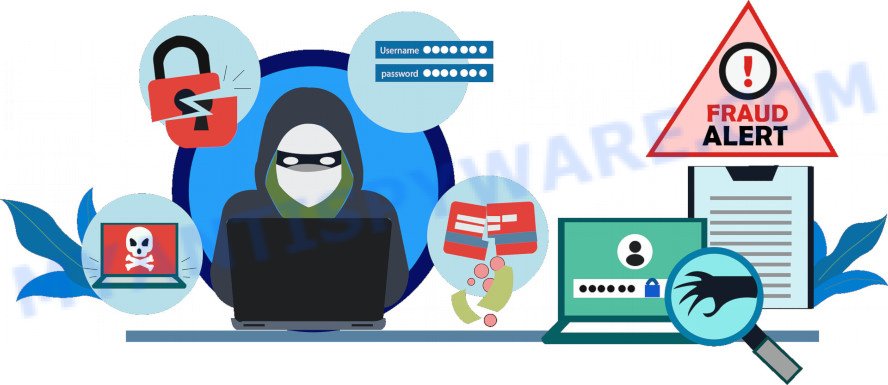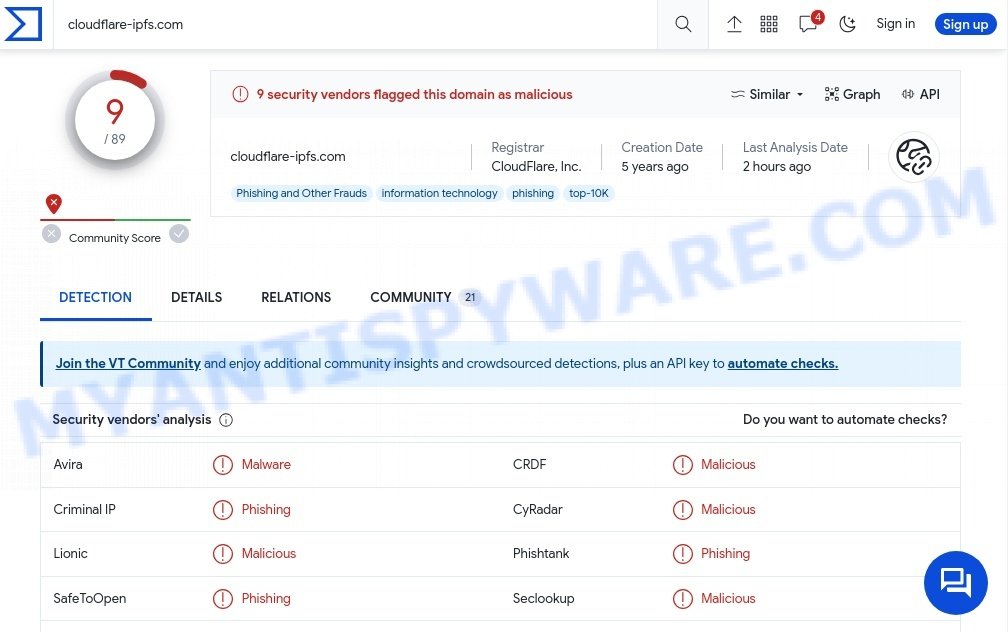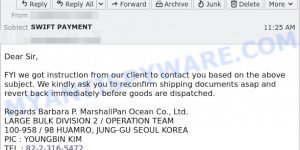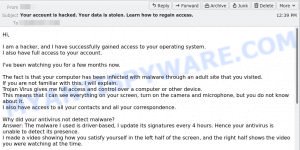Have you received an email with the subject “Deactivation Request In Progress” or a similar title, claiming that your email account is on the brink of deactivation? Be cautious; it’s a scam. These fraudulent emails typically inform recipients of an impending email account deactivation, citing a specific date when this fictitious deactivation request was allegedly received. The goal is to create a sense of urgency and panic.
In this article, we’ll delve into the details of the “Email Deactivation In Progress” scam, how it operates, and what you can do to protect yourself from falling victim to it.

Table of Contents
Understanding the Scam
The “Email Deactivation In Progress” scam is a fraudulent email scheme that preys on people’s fears about losing access to their email accounts. It begins with an email that falsely claims a deactivation request for the recipient’s email account is in motion, complete with a specific date and time for deactivation. This alarming message aims to create panic and urgency.
The “Email Deactivation In Progress” Email reads as follow:
Subject: Deactivation Request In Progress
Email Deactivation in progress
Dear Valued –
Notice indicates that you recently made a request to deactivate your email account on 10/07/2023 3:07:27 a.m.
If this request was made accidentally, this request will be processed shortly.
if it wasnt requested you, you are advised to cancel the request below.
CANCEL DEACTIVATION REQUEST
However if you do not cancel this request your email account will be deactivated permanently and all your email data will be lost permanently.– Server Support 2023
The goal of the scam is to get recipients to click on a “CANCEL DEACTIVATION REQUEST” link within the email. However, this link redirects them to a fake login page that mimics their email service provider’s login. Unsuspecting victims are then tricked into entering their email address and password, which the scammers use to gain unauthorized access to the victim’s email account.
Signs of the “Email Deactivation In Progress” Email Scam:
To recognize this phishing email and others like it, watch for these common signs:
- Urgent Language: Phishing emails often use urgent or threatening language to pressure recipients into taking immediate action.
- Generic Greetings: Phishing emails may use generic greetings like “Dear User” rather than addressing you by name.
- Suspicious Links: Hover your mouse over any links without clicking to see where they actually lead. In this case, the link goes to ipfs.io, a known malicious and phishing site.
- Unexpected Requests: Be cautious of unexpected requests for personal information, especially login credentials or passwords.
- Poor Grammar and Spelling: Phishing emails often contain grammar and spelling errors.
How the “Email Deactivation In Progress” Email Scam Works
The “Email Deactivation In Progress” email scam is a crafty scheme designed to manipulate the recipient’s emotions and steal their login credentials. The scam begins with the victim receiving an email with a subject line that often reads “Deactivation Request In Progress” or something similar. This immediately creates a sense of urgency and concern.
🧐 Fictitious Deactivation Claim
Inside the email, the scammers make a false assertion that a deactivation request for the recipient’s email account has been initiated. To add credibility, they specify a particular date and time when this imaginary deactivation will take place.
🤯 Triggering Panic and Fear
The email aims to induce panic and fear in the recipient. The fear of losing access to one’s email account, which may contain essential personal and professional information, is a powerful emotional trigger.
🆘 The “Rescue” Button
To “cancel” the supposed deactivation process, the email includes a prominent button or link that is often labeled “CANCEL DEACTIVATION REQUEST”. This is where the trap is set.
🌐 Phishing Redirect
When the unsuspecting recipient clicks on the “CANCEL DEACTIVATION REQUEST” link, they are not taken to a legitimate account management page. Instead, they are redirected to a fake website (cloudflare-ipfs.com) that closely resembles the login page of their email service provider.
VirusTotal flagges cloudflare-ipfs.com as phishing and malicious:

🕵️ Credential Theft
The victim, now on the phishing website, is prompted to enter their email address and password to stop the deactivation. Believing this is a legitimate action, they willingly provide their login credentials. However, these credentials are immediately harvested by the scammers.
A fake Sign In page:

🚀 Exploitation and Further Scams
With access to the victim’s email account, the scammers can engage in various fraudulent activities. They may misuse the account to send spam, access sensitive information, or even perpetrate further scams using the victim’s identity.
📧 What to Do If You Receive Such a Phishing Email
Here are the steps you should take if you receive an email that appears to be a phishing attempt:
🚫 Do Not Click Links
The most crucial step is to avoid clicking on any links or downloading any attachments from suspicious emails. Phishing emails often rely on these links to lead you to fraudulent websites or download malware onto your device.
🔍 Verify Legitimacy
Instead of acting on the email’s content, contact the organization or service directly through official channels. Use contact information you find independently, not any provided in the suspicious email, to verify if the email is legitimate. For example, if you receive a suspicious email about your email account, go directly to your email provider’s website and contact their support.
🚀 Report It
Most email providers have built-in features to report phishing emails. Use these features to help protect yourself and others. Reporting the email can trigger an investigation by your email provider or relevant authorities.
🔒 Change Password
If, unfortunately, you’ve already clicked on a suspicious link and entered your login credentials, it’s vital to change your password immediately for the affected account. This action helps secure your account against unauthorized access.
By following these steps, you can protect yourself from falling victim to phishing scams, maintain the security of your accounts, and contribute to the fight against cybercrime. Remember, staying cautious and informed is your best defense against phishing attempts.
Examples of such scams
The “Email Deactivation In Progress” email scam is just one of the many deceptive schemes that prey on individuals’ fears and exploit their privacy concerns. Unfortunately, this type of scam is not unique, and there are various similar scams circulating online.
By examining these examples, we can better recognize the warning signs and arm ourselves with knowledge to avoid becoming victims of fraudulent schemes. Take a closer look at the following scams: ‘Got You, You Got Owned’ Email Scam, Your Account is Hacked. Your Data is Stolen. Email Scam, I am a professional hacker EMAIL SCAM and let’s learn how to safeguard ourselves from their deceitful tactics. Remember, knowledge is power.
- Geek Squad Email Scam (May 2023)
- Reconfirm Shipping Documents Scam email
- Cash Settlement Awarded Email Scam
- Financial Assistance Department Email Scam
- Your account is hacked. Your data is stolen. Email Scam
Summary Table for the “Email Deactivation In Progress” Email Scam
| Name | Email Deactivation In Progress Email Scam |
|---|---|
| Type | Email phishing scam |
| Subject | “Deactivation Request In Progress” or something similar |
| Phishing websites | cloudflare-ipfs.com |
| Danger Level | High |
| Damage | Unauthorized access to email accounts, identity theft |
| Tactics | Urgent language, fraudulent links, impersonation |
| Distribution | Via spam emails |
| Prevention Tips | Verify emails with the sender, hover over links to check their destinations, be cautious with personal information |
| Reporting Info | Use the reporting features of your email provider to report phishing attempts |
Conclusion
Phishing emails like “Email Deactivation In Progress” are common tactics used by cybercriminals to steal sensitive information. By staying vigilant, verifying the legitimacy of emails, and avoiding clicking on suspicious links, you can protect yourself from falling victim to such scams and maintain the security of your online accounts.





















